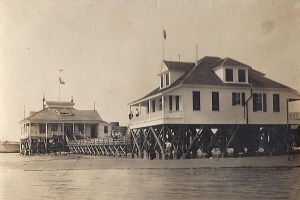
Most immigrants to America came through New York City, either at Castle Garden or Ellis Island. But New York isn’t the only port on our coast, nor were Castle Garden and Ellis Island the only places for immigrants to land.
Port cities line up and down the east coast, and on the west coast as well. Many of these cities found themselves ushering in travelers from other countries. What were these ports and who arrived there? Let’s take a closer look at some of the lesser known ports of immigration.
 Boston
Boston
Immigrants often came from Ireland to Boston through Canada in the mid-1800’s. Passage from England and Ireland was cheaper to Canada than to the United States and was often subsidized by the English government. Immigrants were processed on the docks and only detained at the custom house if they or their paperwork needed further examination. The East Boston Immigration Station was opened in 1920 and closed in 1954.
 Philadelphia
Philadelphia
Philadelphia welcomed immigrants from almost the moment the city was formed in 1682. Dutch and German immigrants fleeing religious persecution came in 1683. In the 1700s it was Germans and the Scotch-Irish. Geography had a limiting effect on immigration through Philadelphia; it is over 100 miles from the ocean up the Delaware River which predictably froze every winter. Nevertheless, more than 1,300,000 immigrants arrived in Philadelphia between 1815 and 1983.
 Baltimore
Baltimore
Irish as well as German immigrants came through Baltimore in the early to mid-1800s, escaping from the potato famine in Ireland and political uprising in the German states. Baltimore gained a reputation as a city with good prospects for those who were willing to work hard. Baltimore’s population increased from 13,503 in 1790 to 212,418 in 1860. The Baltimore & Ohio Railroad played its part in encouraging immigrants to Baltimore, providing passage west to those who wanted to travel on. B&O also had an agreement with a German shipping firm who sold passengers one ticket for both the passage across the ocean as well as on the train heading west. Fell’s Point and Locust Point were the two spots in Baltimore’s harbor where the immigrants landed on American soil.

New Orleans
Immigration to New Orleans peaked in the 1840s and 1850s, before the Civil War. When German immigrants came to New Orleans some stayed and others traveled on to Texas or up the Mississippi River to St Louis or Cincinnati. Often families or even villages would come together, finding strength in numbers as they faced hardships in farming the boggy New Orleans soil or in continued travel.

Galveston
Galveston, Texas was another southern port that welcomed immigrants through its doors. Inexpensive land and freedom to practice their religion enticed many German groups to Texas in the mid-1800s. Quarantine stations, like Pelican Island pictured here, made sure that everyone who set foot on Texas soil was healthy.
 San Francisco, Angel Island
San Francisco, Angel Island
The largest port on the west coast was San Francisco; immigrants from Australia, New Zealand, Mexico, Central and South America, and especially Asia came into the United States here. Laws like the Chinese Exclusion Act of 1882 created immigration restrictions that needed a facility, thus Angel Island was constructed and opened in San Francisco Bay in 1910. Angel Island became a detention center as much as an immigrant processing station with unsanitary conditions, inedible food and strict interrogations. The Administration Building burned in 1940 and by the end of that year all immigrants were processed on a mainland facility. Angel Island was used as a Japanese internment camp after Pearl Harbor was bombed in 1941. It is now a museum.
To research your immigrant ancestor, you can find passenger lists of most major ports in Ancestry and FamilySearch. Use U. S. Census records to find clues about when your ancestor arrived. Naturalization records and passport applications can reveal more information about when your ancestor arrived and where they came from.
But remember to research your ancestor’s experience as well as the facts of immigration. Your ancestors stood in a particular place, had their first view of America from a ship, a dock, or a processing station on an island. Understanding the details of the experience will give you a richer picture of your ancestors’ walk through the immigration door to America.
Sources used:
– Angel Island by the Angel Island Immigration Station Foundation
https://www.aiisf.org/history
– 5 Things About the Port of Boston by Juliana Szucs, July 17, 2014, Ancestry.com blog
https://blogs.ancestry.com/ancestry/2014/07/17/5-things-about-the-port-of-boston/
– Galveston’s Immigration Station, by Martha Deeringer, December 2016
https://www.texascooppower.com/texas-stories/history/galvestons-immigration-station
– German Culture in New Orleans
https://www.neworleans.com/things-to-do/multicultural/cultures/germans/
– New Orleans, Port of Arrival by Elizabeth Lindsay,
http://wiki.genealogytoday.com/New_Orleans_Port_of_Arrival.html
– Philadelphia: Immigrant City by Fredric M. Miller
http://www2.hsp.org/exhibits/Balch%20resources/phila_ellis_island.html
– Point of Entry: Baltimore, the Other Ellis Island by William Connery
http://www.baltimoremd.com/charm/pointofentry.html
Discover more from Cook Memorial Public Library District
Subscribe to get the latest posts sent to your email.
Categories: Genealogy
Tags: Genealogy
